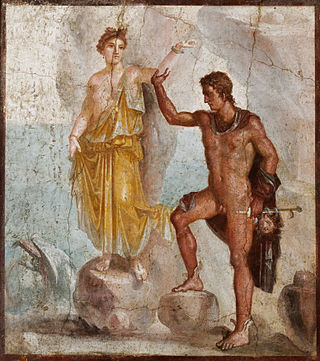
In Greek mythology, Andromeda is the daughter of Cepheus, the king of Aethiopia, and his wife, Cassiopeia. When Cassiopeia boasts that she is more beautiful than the Nereids, Poseidon sends the sea monster Cetus to ravage the coast of Aethiopia as divine punishment. Queen Cassiopeia understands that chaining Andromeda to a rock as a sacrifice is what will appease Poseidon. Perseus finds her as he is coming back from his quest to decapitate Medusa, and brings her back to Greece to marry her and let her reign as his queen. With the head of Medusa he turns Cetus to stone to stop it from terrorizing the coast any longer.

Minerva is the Roman goddess of wisdom, justice, law, victory, and the sponsor of arts, trade, and strategy. Minerva is not a patron of violence such as Mars, but of strategic war. From the second century BC onward, the Romans equated her with the Greek goddess Athena. Minerva is one of the three Roman deities in the Capitoline Triad, along with Jupiter and Juno.

Pegasus is a winged horse in Greek mythology, usually depicted as a white stallion. He was sired by Poseidon, in his role as horse-god, and foaled by the Gorgon Medusa. Pegasus was the brother of Chrysaor, both born when their mother was decapitated by Perseus. Greco-Roman poets wrote about his ascent to heaven after his birth and his obeisance to Zeus, who instructed him to bring lightning and thunder from Olympus.
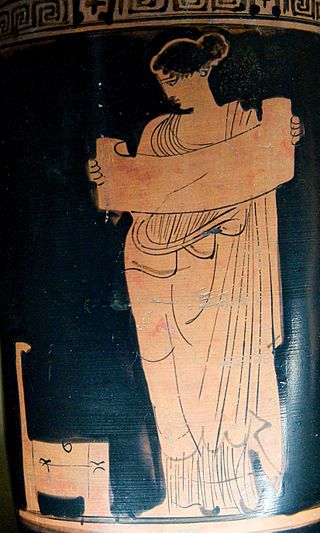
In ancient Greek religion and mythology, the Muses are the inspirational goddesses of literature, science, and the arts. They were considered the source of the knowledge embodied in the poetry, lyric songs, and myths that were related orally for centuries in ancient Greek culture.

In Greek mythology, Hippocrene is a spring on Mount Helicon. It was sacred to the Muses and was said to have formed when the winged horse Pegasus struck his hoof into the ground, whence its name which literally translates as "Steed/Horse's Fountain". The water was supposed to bring forth poetic inspiration when imbibed.

In Greek mythology, Perseus is the legendary founder of the Perseid dynasty. He was, alongside Cadmus and Bellerophon, the greatest Greek hero and slayer of monsters before the days of Heracles. He beheaded the Gorgon Medusa for Polydectes and saved Andromeda from the sea monster Cetus. He was the son of Zeus and the mortal Danaë, as well as the half-brother and great-grandfather of Heracles.
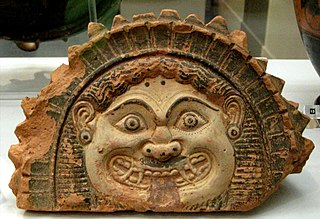
In Greek mythology, Medusa, also called Gorgo, was one of the three Gorgons. Medusa is generally described as a human female with living snakes in place of hair; her appearance was so hideous that anyone who looked upon her was turned to stone. Medusa and her Gorgon sisters Euryale and Stheno were usually described as daughters of Phorcys and Ceto; of the three, only Medusa was mortal.

Mount Helicon is a mountain in the region of Thespiai in Boeotia, Greece, celebrated in Greek mythology. With an altitude of 1,749 metres (5,738 ft), it is located approximately 10 kilometres (6 mi) from the north coast of the Gulf of Corinth. Some researchers maintain that Helicon was also the Greek name of mount Rocca Salvatesta in Sicily as a river started from it was called also Helikon.

The Royal Museums of Fine Arts of Belgium are a group of art museums in Brussels, Belgium. They include six museums: the Oldmasters Museum, the Magritte Museum, the Fin-de-Siècle Museum, the Modern Museum, the Antoine Wiertz Museum and the Constantin Meunier Museum.

Joos de Momper the Younger or Joost de Momper the Younger was a Flemish landscape painter active in Antwerp between the late 16th century and the early 17th century. Brueghel's influence is clearly evident in many of de Momper's paintings. His work is situated at the transition from late 16th-century Mannerism to the greater realism in landscape painting that developed in the early 17th century. He achieved considerable success during his lifetime.
Pegasides were nymphs of Greek mythology connected with wells and springs, specifically those that the mythical horse Pegasus created by striking the ground with his hooves.

The Madonna at the Fountain is a 1439 oil on panel painting by the early Netherlandish artist Jan van Eyck. It belongs to van Eyck's late work, and is his last signed and dated painting. It retains its original frame, which bears the inscription; "ALS IXH CAN", "JOHES DE EYCK ME FECIT + [COM]PLEVIT ANNO 1439

The Oldmasters Museum is an art museum in the Royal Quarter of Brussels, Belgium, dedicated to European painters from the 15th to the 18th centuries. It is one of the constituent museums of the Royal Museums of Fine Arts of Belgium.
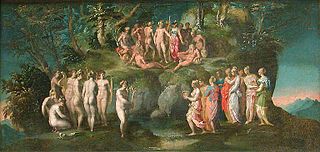
In Greek mythology, the Pierides or Emathides (Ἠμαθίδες) were the nine sisters who defied the Muses in a contest of song and, having been defeated, were turned into birds. The Muses themselves are sometimes called by this name.

The Old Folks Sing, the Young Folks Chirp is a 1638–1640 oil-on-canvas painting by the Flemish artist Jacob Jordaens, now in the Royal Museum of Fine Arts Antwerp. He painted several works with this title, a Dutch proverb – this is the earliest of them, whilst another is now in Valenciennes.

Adrienne is a 1919 painting by the Flemish artist Gustave Van de Woestyne, now in the Royal Museum of Fine Arts, Antwerp. Its subjects are Adrienne de Zutter and her dog. It shows the influence of the English landscape artist William Turner, whose work de Woestyne had probably seen during the war.

Gaston and His Sister is a 1923 Expressionist oil on canvas painting by the Flemish artist Gustave Van de Woestijne, now in the Royal Museum of Fine Arts, Antwerp.

Portrait of Stephan Geraedts, Husband of Isabella Coymans is an oil on canvas painting by Dutch Golden Age painter Frans Hals. The painting was originally part of a couple of pendant wedding portraits. Hals probably painted the present portrait, Stephanus Geraerdts', alderman in Haarlem, and the accompanying portrait of the latter's wife Isabella Coymans around 1650–1652, six or seven years after their marriage in 1644. Isabella's portrait is now in a private collection in Paris.

The Preacher Eleazar Swalmius is a 1637 oil-on-canvas painting by the Dutch artist Rembrandt. It is currently owned by the Royal Museum of Fine Arts in Antwerp. The painting has been certified a real Rembrandt. The painting was listed in 1727 in the catalog of the Duke of Orléans collection, as a portrait of an Amsterdam mayor by Rembrandt. It remained in the noble family's possession until 1792, when Duke Louis-Philippe-Joseph sold the entire collection to finance his political career and pay off debts. The painting passed through several English collections into the hands of the Bourgeois brothers, art dealers from Cologne, who sold the painting as an original Rembrandt to the museum in 1886. The painting was stored away for a long time due to doubts cast over its authenticity.
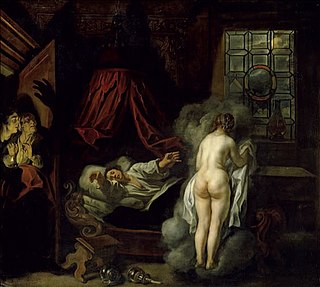
Nocturnal appearance or Night vision is a painting made by Jacob Jordaens around 1650. It is in the collection of the Staatliches Museum Schwerin. The title of the painting is also given as A dream. The meaning and subject of the painting depicting a nude woman seen from the back in a dark bedroom with a man asleep on a bed and two onlookers behind a half open door are still a matter of contention among art historians. A second version of the painting was at the Thore (Burger) sale in Paris on 1892, then in the van Hall sale in Antwerp in 1836 and finally in 1905 it was in Paris with art dealer Franz Kleinberger who exhibited it in Antwerp.






















